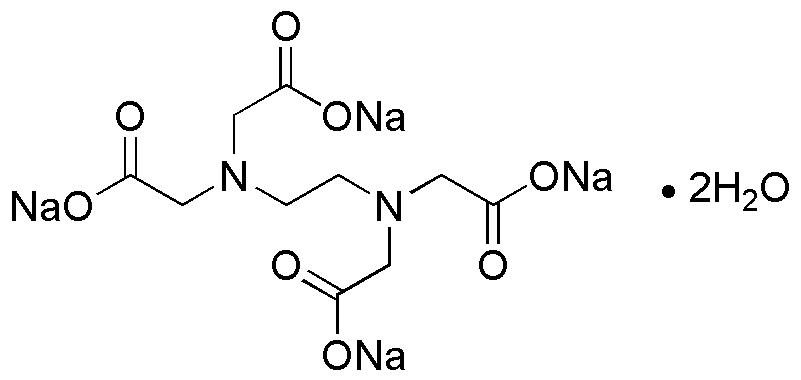Ethylenediaminetetraacetic acid disodium salt, dihydrate is widely utilized in research focused on:
- Metal Ion Chelation: This compound effectively binds to metal ions, making it invaluable in various industries such as water treatment, where it helps remove harmful heavy metals from wastewater.
- Pharmaceutical Formulations: It is commonly used in the pharmaceutical industry to stabilize medications by preventing metal ion-induced degradation, ensuring the efficacy of drugs.
- Food Preservation: In the food industry, it acts as a preservative by sequestering metal ions that can catalyze spoilage, thus extending the shelf life of products.
- Laboratory Reagents: Researchers frequently use it in biochemistry and molecular biology as a reagent for various assays, particularly in studies involving enzyme activity and protein interactions.
- Cosmetic Applications: The compound is also found in cosmetic formulations, where it helps to stabilize products and enhance their effectiveness by preventing metal ion contamination.
General Information
Properties
Safety and Regulations
Applications
Ethylenediaminetetraacetic acid disodium salt, dihydrate is widely utilized in research focused on:
- Metal Ion Chelation: This compound effectively binds to metal ions, making it invaluable in various industries such as water treatment, where it helps remove harmful heavy metals from wastewater.
- Pharmaceutical Formulations: It is commonly used in the pharmaceutical industry to stabilize medications by preventing metal ion-induced degradation, ensuring the efficacy of drugs.
- Food Preservation: In the food industry, it acts as a preservative by sequestering metal ions that can catalyze spoilage, thus extending the shelf life of products.
- Laboratory Reagents: Researchers frequently use it in biochemistry and molecular biology as a reagent for various assays, particularly in studies involving enzyme activity and protein interactions.
- Cosmetic Applications: The compound is also found in cosmetic formulations, where it helps to stabilize products and enhance their effectiveness by preventing metal ion contamination.
Documents
Safety Data Sheets (SDS)
The SDS provides comprehensive safety information on handling, storage, and disposal of the product.
Product Specification (PS)
The PS provides a comprehensive breakdown of the product’s properties, including chemical composition, physical state, purity, and storage requirements. It also details acceptable quality ranges and the product's intended applications.
Certificates of Analysis (COA)
Search for Certificates of Analysis (COA) by entering the products Lot Number. Lot and Batch Numbers can be found on a product’s label following the words ‘Lot’ or ‘Batch’.
*Catalog Number
*Lot Number
Certificates Of Origin (COO)
This COO confirms the country where the product was manufactured, and also details the materials and components used in it and whether it is derived from natural, synthetic, or other specific sources. This certificate may be required for customs, trade, and regulatory compliance.
*Catalog Number
*Lot Number
Safety Data Sheets (SDS)
The SDS provides comprehensive safety information on handling, storage, and disposal of the product.
DownloadProduct Specification (PS)
The PS provides a comprehensive breakdown of the product’s properties, including chemical composition, physical state, purity, and storage requirements. It also details acceptable quality ranges and the product's intended applications.
DownloadCertificates of Analysis (COA)
Search for Certificates of Analysis (COA) by entering the products Lot Number. Lot and Batch Numbers can be found on a product’s label following the words ‘Lot’ or ‘Batch’.
*Catalog Number
*Lot Number
Certificates Of Origin (COO)
This COO confirms the country where the product was manufactured, and also details the materials and components used in it and whether it is derived from natural, synthetic, or other specific sources. This certificate may be required for customs, trade, and regulatory compliance.


